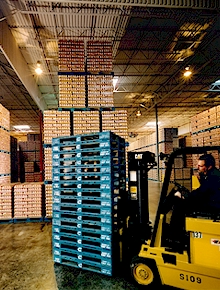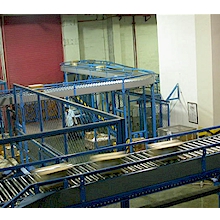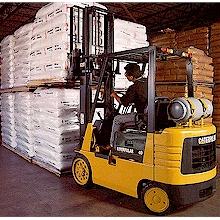
Logistics Software; The Big Leap Forward ... OR NOT ?
Scan the latest logistics sector research, examining the industry’s intentions to adopt new information technology tools, and one can be nothing less than impressed.
For the very clear picture portrayed, is one in which the vast majority of individual supply chain companies say they are currently poised to install a broad array of advanced new computer systems. Software products that are exclusively focused on the exacting demands of logistics and the strategic challenges this is seen to face.
Take, for example, the Deloitte Touche Consulting survey released late last year.
Among other things, this showed that 80% of respondents said they would launch a major supply chain initiative in the next 12 months. Some 97% ranking supply chain management as being of pivotal importance to their companies’ long term success. Even more pointedly, three quarters of the canvassed logistics and manufacturing organisations, expressed dissatisfaction with their companies’ present IT. Some 50% noting that they would buy software applications additional to ERP (corporate) systems to provide the necessary support to their supply chain activities.
The Deloitte Touche findings also give us the following snapshot of exactly what those additional software applications are predicted to be.
Software Proposed to have In 2 Years
Table One: Deloitte & Touche Consulting Group
Warehouse Management Systems 37%
Performance Measurement 39%
Production Scheduling 27%
Freight Payment 24%
Distribution Scheduling 37%
Transport Management 34%
Capacity Planning 32%
Maintenance 29%
Supply Chain Optimisation 53%
Looked at superficially, such research suggests that logistics has never been more poised to enhance its efficiency. Never been so ready to adopt the latest tools available to lower its costs and enhance customer service. And never been more attuned to the demanding realities of the modern IT-driven world.
On the other hand, however, it can also be argued that the same figures simply demonstrate logistics’ very minimal use of information technology to date. Meaning that the substantial implementation of new systems, that is now slated, is more about trying to catch up with other areas of corporate efficiency than it is about anything else. In such a context, the all too common complaint, at least among supply chain professionals, is that senior management has effectively kept their operations in the computer dark ages. To these senior executives – almost never coming from a supply chain background – places like the warehouse have remained the ‘black hole’ of company efficiency. So that while logistics itself has been long and clearly committed to vastly streamlining its operations, those at the top of the organisational ladder have undoubtedly blocked the much needed progress. As one frustrated industry member very recently observed: "Our company has just spent over 18 months and hundreds of thousands of dollars implementing its new ERP systems. These may well do a lot for a whole raft of departments. However at day’s end they were never intended to do anything for logistics - and nothing is precisely what has been delivered." A single voice of frustration that clearly speaks for many |  |
But now many of those new ERP systems have been installed. The inordinate corporate focus on them in the past few years having been driven by, among other things, the urgent need to address the ubiquitous Year 2000 computer problem. So with all that satisfactorily off the agenda, has the time finally arrived when logistics can get its much needed share of the IT budget? Will logistics, at long last, begin to put into place the IT tools it really needs.
Certainly the research we have already looked at suggests the answer is yes. Indeed as one leading US industry commentator, inspired by the Deloitte findings, concluded "the age of supply chain management has arrived".
 | Sadly though, such assessments may just be a little over optimistic. And without trying to embrace that argument in chapter and verse, let’s look at one very critical problem that underlines such thinking. A problem that stresses there is a very big difference between what a company might imagine it wants from its logistics systems and what it actually needs. To explain, let us first make the all too obvious point that technology is advancing at an astronomical rate. Which guarantees that what is leading edge and world’s best practice today, is old hat and passe tomorrow. A scenario that is as true in the application of IT to the supply chain as it is to every other field of endeavor. Simply put, today’s logistics systems can now deliver far in excess of what similar applications were providing just a short while ago. New facilities and features that are not about technology just for technology sake, but rather to answer the, often dictatorial, demands of distribution’s end customers. |
And therein lies the real danger. For given that logistics practitioners have been waiting for systems for so long, it is likely that what is now available has substantially overtaken their perceptions of what those systems really can do. So in the stampede to catch up, no matter how important that is, the real risk is that what will at long last be installed, are yesterday’s solutions to yesterday’s challenges
Consider for instance, warehouse management systems (WMS), the application at the head of Deloittes ‘most wanted’ list of applications.
These IT solutions have now been available for quite a time. Indeed some forward thinking organisations are already marking upwards of a decade of effective WMS use. So it might be imagined that what this software can deliver is now pretty well understood. Unfortunately that is not necessarily so. For what the systems in question once did, is only a small part of what they can now do.
Traditionally, the arguments for warehouse software focussed on productivity gains, improvements in operational efficiency and cost savings. Obviously compelling arguments that have been examined by, among many others, the independent and highly respected Gartner Group. That organisation’s survey of the real life experiences of WMS users systems, demonstrated the following corporate gains.
Benefits of Warehouse Management Systems
Source: Gartner Group
Inventory accuracies approaching 99.9%
Inventory reductions of up to 50%
Direct labour savings of up to 40%
Indirect labour savings of up to 15%
Space utilization increases of 20%
Physical inventory execution costs eliminated
Shipping accuracies of 98% plus
Potent justifications for adopting WMS today as much as before. But the real point is that now they should only be part of the imperative. An important part, but a part none the less.
An argument that is singularly sustained by looking at the demands now being placed on third party warehouse operators by their prospective clients. Equally by looking at what those self same third party organisations are currently demanding when they, in turn, need to look at new WMS to underwrite the competitiveness of their service.
In essentially all instances, the inventory of those ‘demands’ still stresses the traditional cost and efficiency arguments, with the added emphasis on the latter’s impact on enhanced customer service. One would expect nothing less. But now, and commanding equal or even greater emphasis, is a welter of requirements that are all about the WMS’ capability to handle, manage, orchestrate and report on information. And its ability to do exactly the same for a gaggle of enquiries that can be made on that information. Again let’s simplify the thesis by taking but one basic example of what we are looking at. An example that really should be of as much concern to a third party warehouse, as to a client of contract warehousing, as to any organisation electing to fully manage its distribution in-house. |  |
Also an example that is well summed up by those three words, now appearing in a number of more strategically focussed WMS specifications, that demand that the system provide "Web enabled access".
Again let’s simplify the thesis by taking but one basic example of what we are looking at. An example that really should be of as much concern to a third party warehouse, as to a client of contract warehousing, as to any organisation electing to fully manage its distribution in-house.
Also an example that is well summed up by those three words, now appearing in a number of more strategically focussed WMS specifications, that demand that the system provide "Web enabled access".
To determine the relevance of this, just ponder a very few randomly selected things that such a Web-enabled warehouse management system can offer. Of great appeal, for example, might be it ability to:
- Accept sales orders and other key transactions from customers, over the internet in real time.
- Enable all, or perhaps just key, customers to make online enquiries to determine the status of their orders.
- Allow enquiries on stock levels and their uncommitted availability, by a diverse range of approved company and third party individuals.
- Enable company purchase orders to be entered online, so that the warehouse is kept fully up to date with expected deliveries.
- Permit suppliers to advise product shipments to the warehouse, again over the internet.
All such capabilities being delivered with utmost control and security and with substantial economy.
This, of course, is all about what many are now referring to as ‘e-commerce’ or ‘e-business’. The rapidly evolving area of IT application that the Gartner Group sees as "the number one issue for CIOs (companies’ chief information executives) in the year 2000". And while it is not argued that it should enjoy exactly the same priority in the minds of logistics management, our thesis does suggest that it needs to become an integral part of how each and every proposed new system is defined and selected.
In short, to do anything less, really would be to take the risk of adopting yesterday’s solutions to yesterday’ challenges. And should you be left in any doubt about this, reflect on just two more research statistics. Right now in the United States, 30% of all companies conduct at least some of their sales using the web. By year’s end, that figure will exceed 55%.


